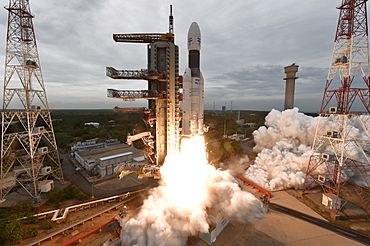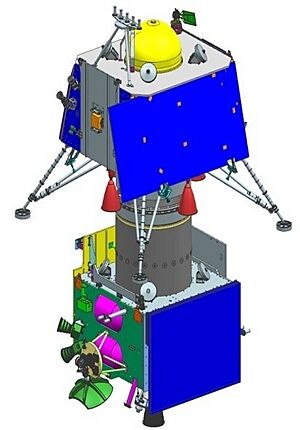Chandrayaan programme facts for kids

LVM3 M1 lifting off with Chandrayaan-2 on 22 July 2019
|
|
| Country | India |
|---|---|
| Organization | ISRO |
| Purpose | Exploration of the Moon |
| Status | Active |
| Program history | |
| Cost | ₹1,364 crore (US$230 million) |
| Duration | 2008–present |
| First flight | Chandrayaan-1, 22 October 2008 |
| Last flight | Chandrayaan-3, 14 July 2023 |
| Launch site(s) | Satish Dhawan Space Centre |
| Vehicle information | |
| Launch vehicle(s) |
|
The Chandrayaan programme (which means "Moon Vehicle" in Sanskrit) is India's exciting journey to explore the Moon. It's run by the Indian Space Research Organisation (ISRO). This program uses different types of spacecraft, including orbiters that fly around the Moon, landers that gently touch down on its surface, and rovers that drive around to explore.
So far, there have been three main missions. The first two spacecraft that orbited the Moon were very successful. Sadly, the lander and rover from the Chandrayaan-2 mission crashed. But the good news is, Chandrayaan-3 successfully landed on the Moon on August 23, 2023! This made India the first country to land a spacecraft near the Moon's lunar south pole. It also made India only the fourth country ever to land on the Moon.
Contents
Exploring the Moon: The Chandrayaan Missions
The Chandrayaan programme is made up of several missions. Each mission helps us learn more about the Moon. ISRO plans to send even more missions in the future.
Phase 1: Orbiting and Impacting
Chandrayaan-1: India's First Moon Mission
The idea for an Indian mission to the Moon started in 1999. Many Indian scientists thought it was a great idea. In 2003, the Indian government approved the project. This was a big step for India's space program!
Chandrayaan-1 was launched on October 22, 2008. It used ISRO's powerful PSLV-XL rocket. This mission was a huge success! A special part of the spacecraft, called the Moon Impact Probe, found signs of water on the Moon. Chandrayaan-1 also helped create maps of the Moon's surface.
Phase 2: Soft Landings and Rovers
Chandrayaan-2: A Bold Attempt
The plan for Chandrayaan-2 was approved in 2008. It was supposed to include an orbiter, a soft lander, and a rover. The mission was delayed because another country, Russia, couldn't build the lander in time. So, India decided to build the lander on its own!
Chandrayaan-2 launched on July 22, 2019, using the LVM3 rocket. The orbiter successfully reached the Moon's orbit. However, the lander had a problem and crashed when it tried to land on September 6, 2019. Even though the landing failed, the orbiter is still working and sending back important scientific information. It is expected to work for many more years.
Chandrayaan-3: A Historic Landing
After the Chandrayaan-2 landing attempt, ISRO decided to try again. This new mission was called Chandrayaan-3. Its main goal was to successfully land on the Moon. It also aimed to show that a rover could move around on the Moon's surface. Finally, it would do scientific experiments right there on the Moon.
Chandrayaan-3 launched on July 14, 2023. It carried a lander, a rover, and a propulsion module. The lander and rover made a perfect landing near the lunar south pole on August 23, 2023. This was a truly historic moment for India and for space exploration!
Phase 3: Collecting Samples
Lunar Polar Exploration Mission (LUPEX)
The next mission in the Chandrayaan series might be called Chandrayaan-4, or LUPEX. India is working with Japan on this mission. It is planned for sometime between 2026 and 2028.
LUPEX will be a lander and rover mission. It will go to the Moon's polar region. Its job will be to collect and study lunar material. It will also test technologies that help spacecraft survive the long, cold lunar night.
Chandrayaan Missions Overview
- Landing
Successful hard landing
Successful soft landing
Unsuccessful landing
- Mission
Successful and inactive
Active
Unsuccessful
| Mission |
Launch Date |
Launch Vehicle |
Orbital Insertion Date | Landing Date | Return Date | Status | ||||
|---|---|---|---|---|---|---|---|---|---|---|
| Main Mission |
Extended Mission |
Expected Mission Duration | Total Mission Duration | Notes | ||||||
| Phase 1: Orbiter and impactor | ||||||||||
| Chandrayaan-1 | 22 October 2008 | PSLV-XL | 8 November 2008 | 14 November 2008 | – | Success | – | 2 years | 310 days | India's first Moon mission; found water on the Moon. |
| Phase 2: Soft landers and rovers | ||||||||||
| Chandrayaan-2 | 22 July 2019 | LVM3 | 20 August 2019 | 6 September 2019 | – | Success | Ongoing | 7.5 years | 6 years, 4 months, 6 days elapsed | First Indian mission with a lander and rover; lander crashed. |
| Chandrayaan-3 | 14 July 2023 | 5 August 2023 | 23 August 2023 | – | Ongoing | TBD | 14 days | 2 years, 4 months, 16 days elapsed | First successful Indian Moon landing; first landing near the lunar south pole. | |
| Phase 3: Onsite sampling | ||||||||||
| LUPEX | TBD 2026-28 | H3 | TBD | TBD | – | TBD | TBD | 6 months | TBD | A joint mission with JAXA (Japan's space agency). |
Images for kids
-
Images taken by Moon Impact Probe before performing a hard landing near the outer rim of Shackleton crater in the Lunar south pole region.
-
Second confirmation of water on Moon by Chandrayaan-1's Moon Mineralogy Mapper, three months after the discovery by Moon Impact Probe.
-
Far side of the Moon as viewed by Chandrayaan-2's LI4 (Lander Imager 4) Camera, 21 August 2019.
See also
- List of missions to the Moon
- Indian Mars exploration missions
- Indian Human Spaceflight Programme







